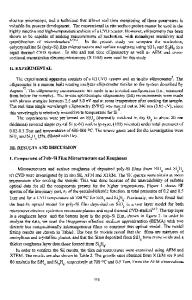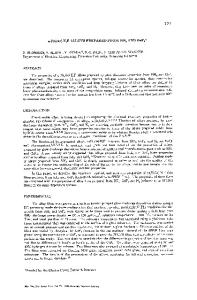Deposition of Photoluminescent Nanocrystalline Silicon Films by Si 4 -SiH 4 -H 2 Plasmas
- PDF / 341,692 Bytes
- 6 Pages / 414.72 x 648 pts Page_size
- 92 Downloads / 365 Views
exhibiting RT visible PL at 1.82 eV. Room temperature and visible PL, detected in situ and in real time during the formation of nanopowders in silane r.f. plasmas, has been reported by Courteille et al. [8]. These authors have found that the oxygen addition does not affect the intensity of 1.6 eV PL peak, in contrast to what commonly found for PS [3] or post processed nc-Si [1]. Here, it is important to emphasize that Veprek et al. [1] have reported the appearance of a new PL peak at 2.7 eV after the oxidation of the nc-Si:H films. As for the growth process, the deposition of nanocrystalline silicon is related to the important selective etchant role of hydrogen atoms towards the amorphous phase with respect to the crystalline structure. This etching process promotes the nucleation and the crystallization of a-Si:H at low temperature with desired grain sizes [5, 6]. Thus, the use of silicon tetrafluoride as silicon precursor can be of some interest, since the presence of fluorine atoms in the growth environment can favour the amorphous-crystalline transition, due to their etchant activity. Tachibana et al. [9] have studied the effect of SiF4 addition to the conventional H 2 diluted silane mixture, and they have confirmed, with an in situ ellipsometric monitoring, that the crystalline fraction increases at high values of SiF 4/SiH 4 ratio. However, to our knowledge no evidence of the visible PL at room temperature from plasma deposited fluorinated materials is reported without a post processing treatment [10]. In the present contribute, we report on preliminary results of fluorinated nanocrystalline silicon (nc-Si:H,F) films, deposited by PECVD technique starting from SiF4SiH4-H 2 mixtures. Emphasis is given on the material characterization and on the most relevant results like PL peak position, electrical activation energy Ea, energy gap Eg, hydrogen content and size of nanocrystals. EXPERIMENTAL nc-Si:H,F films have been prepared by means of PECVD technique in a parallel plate ultra high vacuum (UHV) reactor from SiF 4 -SiH 4 -H2 mixtures. The growth parameters were: nominal deposition temperature 450 'C, pressure 1 Torr, gas flows of the mixture components SiF 4/SiH 4 /H2 10/0.2/82 sccm, and the r.f. (13.56 MHz) power was varied in the range 10 - 50 W. The film growth is carried out on the grounded electrode and simultaneously on different substrates (c-Si, molybdenum and Coming 7059 glass). The deposition rates, rD, evaluated in situ by laser interferometry technique, have been found to be strongly affected by r.f. power. In fact, rD increases from 0.1 to 0.5 A/sec when the power increases from 10 to 50 W. The infrared absorption measurementss of samples deposited on double polished c-Si substrates have been performed by using a FTIR spectrometer (Bomem Michelson 102), which covers the range 400 - 4000 cm- 1 in order to detect the presence of 0 and H by the correspondent absorption of Si-H and Si-O bonds and to evaluate the H content.
810
The x-ray diffraction measurements were performed (Philips PW 1800 diffr
Data Loading...








